Although the monument was very well constructed,
inevitably repairs have had to be made. In the 1950s loose and dangerous
pinnacles were repaired and a lightning conductor installed. Storms
created further damage in 1968 and by 1975 the iron fixings to the
statues had rusted and weakened. There was also debate about cleaning
years of accumulated soot from the structure, but it was suggested
this would only reveal the various types of stone, other than Binny
stone that had been used for repairs.
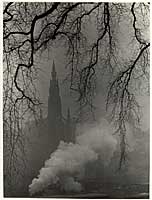 This
photograph (part of the City of Edinbugh Council Central Library
service, Edinburgh Room collection) is entitled ‘Misty Day’
was taken from Market Street in 1956 by photographer Peter Frew,
as part of a photographic competition. It shows the Scott Monument
on a foggy day, shrouded in smoke from the nearby railway. ‘Auld
Reekie’ is an old name for Edinburgh meaning ‘old smokey’.
This would have been a fairly typical smoke filled scene in central
Edinburgh, and contributed to the blackening of the stonework of
the monument and many city centre buildings. This
photograph (part of the City of Edinbugh Council Central Library
service, Edinburgh Room collection) is entitled ‘Misty Day’
was taken from Market Street in 1956 by photographer Peter Frew,
as part of a photographic competition. It shows the Scott Monument
on a foggy day, shrouded in smoke from the nearby railway. ‘Auld
Reekie’ is an old name for Edinburgh meaning ‘old smokey’.
This would have been a fairly typical smoke filled scene in central
Edinburgh, and contributed to the blackening of the stonework of
the monument and many city centre buildings.
In the early 1990s it was proposed that the stone should be cleaned
and a thorough assessment of the structure be made.
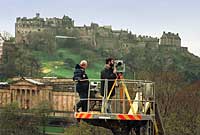 In
the early 1990s, the City of Edinburgh procured a complete photogrammetric
survey of the entire Monument. In
the early 1990s, the City of Edinburgh procured a complete photogrammetric
survey of the entire Monument.
Photogrammetry is the method of preparing accurate measurements
from photography, and is regularly used to survey historic buildings.
Photographs are taken in stereopairs, then, using special equipment,
measured survey drawings can be prepared from this stereo photography.
The process produces very accurate survey drawings, in which every
single architectural detail and each block of stone are drawn out,
as shown on the images below. The stereo photography is also an
invaluable archival record in its own right. The systematic coverage
ensures that every face of the Monument is photographed, and by
viewing the images in stereo, the view of the detail is much enhanced.
Below you can see an example of this process. The two images on
the right are the detailed drawings developed using the photographs
on the left.
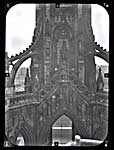
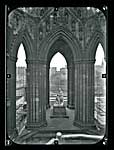
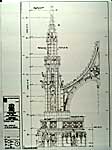
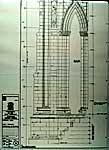
|



